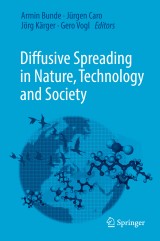Details

Diffusive Spreading in Nature, Technology and Society
|
90,94 € |
|
| Verlag: | Springer |
| Format: | |
| Veröffentl.: | 22.12.2017 |
| ISBN/EAN: | 9783319677989 |
| Sprache: | englisch |
Dieses eBook enthält ein Wasserzeichen.
Beschreibungen
<p>This book deals with randomly moving objects and their spreading. The objects considered are particles like atoms and molecules, but also living beings such as humans, animals, plants, bacteria and even abstract entities like ideas, rumors, information, innovations and linguistic features. The book explores and communicates the laws behind these movements and reports about astonishing similarities and very specific features typical of the given object under considerations. Leading scientists in disciplines as diverse as archeology, epidemics, linguistics and sociology, in collaboration with their colleagues from engineering, natural sciences and mathematics, introduce the phenomena of spreading as relevant for their fields. An introductory chapter on “Spreading Fundamentals” provides a common basis for all these considerations, with a minimum of mathematics, selected and presented for enjoying rather than frustrating the reader.</p>
<p>Epidemic Spreading.- Hot Brownian Motion: Experiment.- Nature-Inspired Transport Optimization.- The Neolithic Transition.- Spreading Innovations.- Expansion of Language Families.- The Expansion of Farming.- Spreading of Failures in the Internet and in Power Grids.- Analyzing Language Shift.- Search for Food of Birds, Fish and Insects.- Uphill Diffusion.- Hot Brownian Motion: Theory.- Dispersal in Plants and Animals.- Diffusive Transport in Non-Equilibrium Steady State.- A New Class of Superspreader.- Transport Systems Living Organisms.- Brain Structure Revealed by Diffusive Spread of Molecules.- NMR Versatility.- Spore Dispersal in Lower Organisms.- Diffusion Processes in Atmospheric Physics.- Language Migration.</p>
Prof. Jörg Kärger<div><div>Professional Career</div><div>1962 – 1968 Studying Physics at Leipzig University</div><div>1968 – 1970 PhD-fellow Leipzig University, Dr. rer. nat. in Physics 1970</div><div>1970 – 1977 Scientific co-worker, Leipzig University</div><div>1977 – 1982 Senior scientific co-worker, Leipzig University</div><div>1978 Habilitation ("Promotion B")</div><div>1982 – 1989 Lecturer, Leipzig University</div><div>1989 – 1994 extraordinary Professor, Leipzig University</div><div>1994 – April 2009 Professor with full chair (Interface Physics), Leipzig University</div><div>since April 2009 Professor emeritus, Leipzig University</div><div><br></div></div><div>Professional Activities and Memberships</div><div>1996 – 1999 Dean of the Faculty of Physics and Earth Sciences at Leipzig University</div><div>1996 – 1999 President of the German Zeolite Association, member of t</div>he FEZA Board (Federation of European ZeoliteAssociations)<div>1997 – 2000 Ombudsman of Leipzig University</div><div>2002 – 2006 Editorship www.diffusion-fundamentals.org (since 2003),</div><div>Microporous and Mesoporous Materials (European Editor 2004 – 2008)</div><div><br></div><div>Membership in Editorial Boards</div><div>Zeolites (1992 – 1997), Adsorption (since 1993), Microporous and</div><div>Mesoporous Materials (since 1993)</div><div>Honours</div><div>1978 Gustav-Hertz-Award </div>of the German Physical Society<div>1980 Leibniz-Medal of the German Academy of Sciences</div><div>1986 Donald-W.-Breck Award of the International Zeolite Association (together</div><div>with H. Pfeifer, D. Freude and M. Bülow)</div><div>1993 Max Planck Research Award of the Alexander-von-Humboldt Foundation and the Max-Planck-Society</div><div>2000 Member of the Saxon Academy of Sciences</div><div>2005 Theodor-Litt-A</div>ward of Leipzig University<div>Research Interest</div><div>Experiment and</div>theory of mass transfer and matter conversion in complex systems<div><br></div><div><br></div><div><p><b>Prof. Dr. Gero Vogl, Wien </b>Dr.phil. (Physik, Universität Wien), Dr. rer.nat.habil. (TU München) Emer. Professor </p></div><p></p><p></p><div><div><p>1965 Dr.phil.<br>1966 assistent physics department TU München<br>1970 head low temperatur lab TU München<br>1974 Habilitation<br>1975 associate professor TU München<br>1977 professor physics (C3) FU Berlin<br>1985-2009 prof. physics University Wien<br>1999 department head Hahn-Meitner-Instituts Berlin<br>1990-1991 member scientific couoncil integration AdW of DDR <br>1991-1993 responsible for evaluation der physics research Autria<br>1991-1998 speaker „Nuclear Solid State Sciences Austsria<br>2002 coordinator net Materials Dynamics BMWFT, international collaboration<br>2002-2004 president Austrian Physical Society </p> <br> </div><div><br></div><div>CV of Jürgen Caro</div><div>Po</div></div>sition: Professor (W3) for Physical Chemistry (chair)<br><div>Academic education and degrees</div><div>1992 Dr. rer. habil. on the application of zeolitic molecular sieves as catalysts,</div><div>adsorbents, nonlinear optical materials, sensor, membrane</div><div>1989 Dr. sc. nat. on the diffusion influence in heterogeneous catalysis</div><div>1977 Dr. rer. nat. on NMR studies of molecular diffusion in porous materials (Mentor: J. Kärger), „summa cum laude“</div><div>1970-1977 Study of Chemistry, University Leipzig, American model: direct after Bachelor, start of</div> PhD study<div>Scientific career</div><div>since 2001 W3 Professor for Physical Chemistry, Leibniz University Hannover</div><div>1994-2001 Leader of the Department „Advanced Materials“ at the Institute for Applied</div><div>Chemistry in Berlin-Adlershof with the working fields ceramics, polymers,</div><div>composites</div><div>1992-1993 Formation of the new group „Nano-composites- molecular sieves as</div> high-tech<div>materials“ at Center for Heterogeneous Catalysis of the KAI in Berlin-Adlershof</div><div>1977-1991 Central Institute for Physical Chemistry of the former East German Academy of</div><div>Sciences with the working fields adsorption, catalysis, porous materials, gas</div><div>separation, supercritical fluids</div><div>Further activities and honours</div><div>2013 Breck Award of the International Zeolite Association</div><div>2013 Ostwald-Medal of the Saxonian Academy of Scien</div>ces at Leipzig<div>2013-2016 Pr</div>ofessor at the Chinese Academy of Sciences at Ningbo, China<div>2014-2017 Visiting Professor at Dalian University of Technology, China</div><div>2014-2017</div><div>P</div>art-time Professor of the University at Panjin, China<div><br></div><div><br></div>
<p>This book deals with randomly moving objects and their spreading. The objects considered are particles like atoms and molecules, just as living beings like humans, animals, plants, bacteria and even abstract entities like ideas, rumors, information, innovations and linguistic features. The book explores and communicates the laws behind these movements and reports about astonishing similarities and very specific features typical of the given object under considerations. Leading scientists in disciplines as different as archeology, epidemics, linguistics and sociology, in contact with their colleagues from engineering, natural sciences and mathematics, introduce into the phenomena of spreading as relevant for their fields. An introductory chapter on “Spreading Fundamentals” provides a common basis for all these considerations, with a minimum of mathematics, selected and presented for enjoying rather than frustrating the reader.</p>
Treats the spreading phenomenon in its universal context Presents mathematics (including computer programming) on an appropirate level so that essentially any reader will appreciate it as a help and useful guide The individual chapters address a broad range of readers from archaeology, epidemics, linguistics, sociology, engineering, natural sciences and mathematics Includes supplementary material: sn.pub/extras
<p>Treats the spreading phenomenon in its universal context </p> <p>Presents mathematics (including computer programming) on an appropirate level so that essentially any reader will appreciate it as a help and useful guide </p> <p>The individual chapters address a broad range of readers from archaeology, epidemics, linguistics, sociology, engineering, natural sciences and mathematics </p>
Diese Produkte könnten Sie auch interessieren:

Femtosecond Optical Frequency Comb: Principle, Operation and Applications

von: Jun Ye, Steven T. Cundiff

149,79 €















